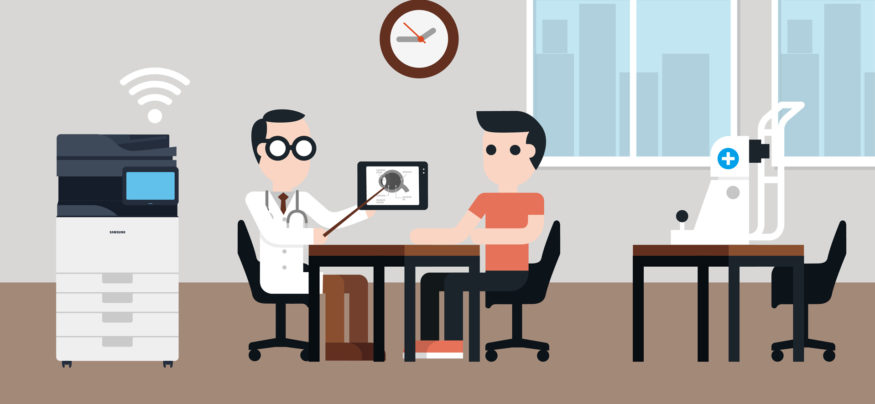In the world of healthcare, the impact of technological trends is amplified and accelerated. In an industry where speed and security are of the essence, outdated technology can be a serious problem when it comes to document management and sharing.
Now, with mobile devices taking the place of PCs and laptops as the connectivity tools of choice, it is unsurprising that healthcare professionals are at the forefront of the movement, as evidenced by the adoption of smart devices and mobile printing in healthcare. If a healthcare environment wants to operate efficiently and fluidly, it’s becoming increasingly important that it embrace mobile integration.
In fact, the impact of mobile devices is arguably greater in healthcare than in any other industry. By 2015, 89 percent of healthcare professionals are projected to utilize smartphones, and 80 percent are projected to utilize tablets, according to Epocrates. The usage trends are consistent across a wide variety of healthcare professionals, from specialists to general practitioners.
In an effort to provide the best possible patient care, it is natural for providers of healthcare to seek out and adopt the most current possible technology. A hospital, clinic or any other healthcare institution that is seeking to do the same, needs to do more than just encourage. A shift to a smarter way of working, in which progressive technology is both implemented and supported, is necessary to maximize patient care capabilities.
Physician shortages and EMR proliferation
Current data indicates a projected shortage of over 45,000 primary care physicians nationally by 2020, according to the Association for American Medical Colleges. And as our investment in EMR systems reaches over $9.3 billion annually, there’s an increasing demand on healthcare professionals to document care through multiple systems, a slow task that reduces time spent in patient-facing care delivery. The result is an ever-growing need for absolute efficiency among physicians and healthcare professionals in general.
Mobile devices could be a vital player in enabling healthcare professionals and administrative staff to do their jobs more efficiently. Efficiency is top of mind for healthcare professionals, with 48 percent calling it their primary area of focus for the next three to five years, according to a survey from Wolters Kluwer Health.
Identifying document needs relative to patient care
Healthcare is a unique sector in regards to the urgency and sensitivity with which documents are handled and shared, even on a daily basis. Identifying the specific printing and document management needs is vital for ensuring the consistent delivery of high-quality patient care.
1. Versatility
In an industry where space, money and time are all at a premium, single-service devices have no place. Standalone printers, copiers and scanners are giving way to versatile multifunction devices that are acting as efficient hubs supporting everything from scanning insurance cards to capturing medical histories to recording treatment notes. Health technology leaders are driving savings by having fewer devices that are more powerful and functional while also boasting a lower overall cost of ownership.
2. Compliance
Medical records, patient history and prescription information are just a small sampling of the types of highly sensitive documents a healthcare professional might encounter on a daily basis. IT leaders are challenged by the sometimes conflicting demands of supporting mobile device use and maintaining strict privacy and regulatory compliance standards. Managing a significant flow of sensitive medical information cannot be compromised, and the ability to control who, where and what people print through features like user authentication and secure release printing makes that possible.
3. Efficiency
With nearly half of all physicians naming efficiency as a primary focus in the next five years, it’s no surprise that they expect the same dedication to optimization from the technology they use. A solution that minimizes the time spent printing, scanning and managing documents, while maximizing time providing care leads to an overall better patient experience. Achieving this is possible through features like serverless operation, cloud capabilities and improved connectivity between printers and devices.
Smarter printing solutions
With the significant presence of mobile devices in healthcare environments, as well as the challenges posed by ineffective mobile integration. Through understanding the demand for efficiency, desire for flexibility and call for uncompromised security in medical document management, a better way to work and care for patients can be achieved. With the latest multifunction printers (MFPs) and customizable printing solutions is how healthcare providers can put this into practice.
With diverse offerings for mobile printing in healthcare, hospitals of all sizes and formats can receive an array of end-to-end document workflow and mobile printing solutions that are customizable for their particular needs.
Designed to be efficient, effective and secure, multifunction printing solutions can keep pace with the technology healthcare professionals’ use in their work and lives. Mobile printing in healthcare, alongside other mobility solutions, can ensure healthcare professionals can work smarter and face fewer obstacles in providing the best possible patient care.
Learn more about how healthcare technology solutions can enhance efficiencies and improve the patient experience.








